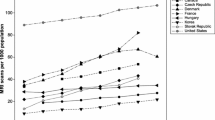Abstract
We devise models and algorithms to estimate the impact of current and future patient demand for examinations on Magnetic Resonance Imaging (MRI) machines at a hospital radiology department. Our work helps improve scheduling decisions and supports MRI machine personnel and equipment planning decisions. Of particular novelty is our use of scheduling algorithms to compute the competing objectives of maximizing examination throughput and patient-magnet utilization. Using our algorithms retrospectively can help (1) assess prior scheduling decisions, (2) identify potential areas of efficiency improvement and (3) identify difficult examination types. Using a year of patient data and several years of MRI utilization data, we construct a simulation model to forecast MRI machine demand under a variety of scenarios. Under our predicted demand model, the throughput calculated by our algorithms acts as an estimate of the overtime MRI time required, and thus, can be used to help predict the impact of different trends in examination demand and to support MRI machine staffing and equipment planning.








Similar content being viewed by others
Notes
Our data was collected and analyzed with the approval of the SCH Institutional Review Board.
The makespan is the maximum completion time over all jobs.
We suspect magnet availability is a mitigating factor.
Using magnet on-times as an estimate of arrival rates does not take reneging into account. However, based on interviews with technologists and doctors at SCH, the occurrence of reneging was insignificant.
We note that the increase could also be due to other factors such as improved efficiency in conducting examinations or an increased proportion of shorter MRI examinations required.
References
Bailey N (1952) A study of queues and appointment systems in hospital out-patient departments, with special reference to waiting-times. J R Stat Soc, B (Methodological) 14:185–199
Cayirli T, Veral E (2003) Outpatient scheduling in health care: a review of literature. Prod Oper Manag 12:519–549
Cox D (1972) Regression models and life-tables. J R Stat Soc, B (Methodological) 34(2):187–220
Garey M, Johnson D (1978) “Strong” NP-completeness results: motivation, examples, and implications. J Assoc Comput Mach 25:499–508
Garey M, Johnson D (1979) Computers and intractability: a guide to the theory of NP-completeness. W.H. Freeman, New York
Green L, Savin S, Wang B (2006) Managing patient service in a diagnostic medical facility. Oper Res 54:11–25
Gupta D, Denton B (2008) Appointment scheduling in health care: challenges and opportunities. IIE Trans 40:800–819
Kalyanasundaram B, Pruhs K (1991) On-line weighted matching. In: Proceedings of the 2nd ACM-SIAM symposium on discrete algorithms, pp 234–241
Kolisch R, Sickinger S (2008) Providing radiology health care services to stochastic demand of different customer classes. OR Spectrum 30:375–395
Leemis L, Park S (2005) Discrete event simulation: a first course. Prentice-Hall, Upper Saddle River
Patrick J, Puterman ML (2008) Improving resource utilization for diagnostic services through flexible inpatient scheduling: a method for improving resource utilization. J Oper Res Soc 58:235–245
Shmoys DB, Tardos E (1993) An approximation algorithm for the generalized assignment problem. Math Program A 62:461–474
Sickinger S, Kolisch R (2009) The performance of a generalized Bailey–Welch rule for outpatient appointment scheduling under inpatient and emergency demand. Health Care Manag Sci 12:408–419
Venables W, Ripley B, Venables W (2002) Modern applied statistics with S-PLUS, 4th edn. Springer Verlag
Vermeulen I, Bohte S, Elkhuizen S, Bakker P, La Poutré H (2008) Decentralized online scheduling of combination-appointments in hospitals. In: Proceedings of ICAPS-2008, the international conference on automated planning and scheduling. Sydney, Australia, pp 372–379
Vermeulen I, Bohte S, Elkhuizen S, Lameris H, Bakker P, Poutré H (2009) Adaptive resource allocation for efficient patient scheduling. Artif Intell Med 46:67–80
Welch J, Bailey NTJ (1952) Appointment systems in hospital outpatient departments. Lancet 259:1105–1108
Acknowledgements
We thank the referees and editor for their extremely helpful comments. Also, we thank Eyjo Ásgeirsson and Cliff Stein for many useful discussions and Tom Crockett for his help with the computational experiments. Finally, we thank the technologists and schedulers at SCH for their valuable information and insights.
Author information
Authors and Affiliations
Corresponding author
Additional information
This paper was supported in part by NSF grants DMS-0703532, DUE-0849955, and a NASA/VSGC New Investigator grant.
Rights and permissions
About this article
Cite this article
Carpenter, A.P., Leemis, L.M., Papir, A.S. et al. Managing magnetic resonance imaging machines: support tools for scheduling and planning. Health Care Manag Sci 14, 158–173 (2011). https://doi.org/10.1007/s10729-011-9153-z
Received:
Accepted:
Published:
Issue Date:
DOI: https://doi.org/10.1007/s10729-011-9153-z




